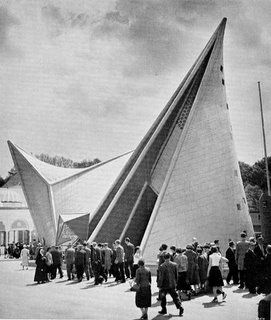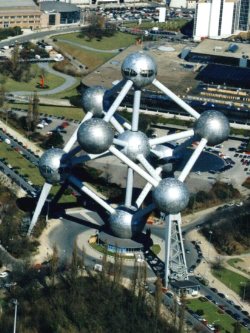The Atomium, Brussels
 Gustave Eiffel built one of the most iconic structures in the world, the famous tower that bears his name, for the International Exhibition of Paris of 1889. Like many of the experimental buildings constructed for exhibitions and world's fairs, it was scheduled to be dismantled many times but never was. Now it would be impossible to destroy it, and the same is true of Buckminster Fuller's geodesic dome for the 1967 World's Fair in Montréal.
Gustave Eiffel built one of the most iconic structures in the world, the famous tower that bears his name, for the International Exhibition of Paris of 1889. Like many of the experimental buildings constructed for exhibitions and world's fairs, it was scheduled to be dismantled many times but never was. Now it would be impossible to destroy it, and the same is true of Buckminster Fuller's geodesic dome for the 1967 World's Fair in Montréal.
However, not all of these unusual structures have survived. One of the worst casualties is Le Corbusier's futuristic Philips Pavilion for the 1958 World's Fair in Brussels, designed in part by Le Corbusier's assistant Iannis Xenakis, who later became an experimental composer. A series of projected images and colored lights was accompanied by a soundtrack played on 400 loudspeakers, Edgard Varèse's Poème Electronique and Iannis Xenakis's Concrète PH in alternation. The soundtrack survives in recordings, but the pavilion was dismantled and has now disappeared. Anyone who can tell me exactly what happened to the Philips Pavilion after it was dismantled will get an Ionarts Cookie.
An article by Jean-Pierre Stroobants (L'Atomium de Bruxelles fait peau neuve, February 17) in Le Monde reports on another unusual structure built for that 1958 World's Fair in Brussels (my translation and links added):
Check out the Atomium Web site to have a look at the inside and outside of the renovation. Hopefully, the Atomium will again be a symbol for Belgian unity. Many Europeans, including the author of the article in Le Monde, think that Belgium is doomed to divide along linguistic borders into French- and Flemish-speaking countries.In theory, it was supposed to be destroyed after the World's Fair of 1958, which made a statement of unshakeable faith in progress, democracy, and peace. Forty-eight years later, the Atomium -- 2,400 metric tons and 102 meters high -- still reigns over the Heysel plateau in Brussels. This one time, the infinite complexity of Belgium did not scuttle an ambitious project: the incredible construction of engineer André Waterkeyn, who died in October 2005, has been renovated in the record time of 22 months. The public will be able to visit the Atomium again beginning on February 18.
The structure, which represents an iron molecule enlarged 165 billion times, today has the proud allure of something miraculous. The aluminum shells of its nine corroded spheres, abused and sullied by time and pigeon droppings, were recovered with stainless steel panels that reproduce, down to the last detail, the building's original look. The German designer Ingo Maurer put in place new interior and exterior lighting that augments the perception of the building's strangeness and strength. The nine spheres, 240 square meters each, were reworked from top to bottom by Belgian architects, determined to allow only the original work's impression of audacity, the strength of the raw material and technique, shine through, perceived in 1958 as a means of promoting the well-being of humankind.






















































No comments:
Post a Comment